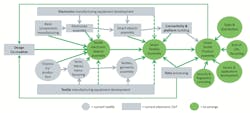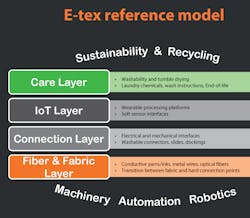E-textile is a booming market in the electronics sector—and in the textile sector. Being at the crossroads of two industries has problems of its own. Christian Dalsgaard, founder and former CTO of Ohmatex in Denmark, learned that the hard way while developing state-of-the-art wearables for the European Space Agency, among others. He argues for standards in e-textile. Senior Technology Editor Bill Wong chats with Christian about this growing need.
Which problems are shaping e-textile nowadays?
There are two clusters of problems—the first cluster has to do with the central challenges of e-textile. The most important one is unifying something hard with something soft, something rigid with something flexible. Also, you need to make a device as small as possible, while maintaining its performance. And then there’s the challenge to make cabling, connectors and electronics sealing that will survive hostile environments—sweat, washing machines, tumble dryers, to name the most obvious.
The second cluster of problems is about the fact that two supply chains are involved in e-textile. One is concentrated around the traditional textile industry, where there’s a group of companies involved in the production of conductive yarn, sensing fabrics, and confectioning garments. The other is concentrated around the production of electronics and mechanical components, involving robotics and automated processes.
Textile and electronics are coming together in e-textile, but they come from very different backgrounds. Some of the elements include price points that are very different and the manufacturing process for cloth is still labor-intensive.
Moreover, the turnaround time in fashion is short. There needs to be a new collection every three months, whereas the turnaround time in electronics is on average two years. Of course, there are exceptions—certain headphones from 2007 are still hot and being sold.
People working in electronics are generally nerds rooted in STEM, while in textile they hate mathematics and science. There’s also a gender factor. In the textile industry, there’s a predominance of women, while in electronics you’ll find mostly men.
The gender aspect influences the industry on many levels, from the people working in it to the solutions consumers are interested in. Women choose clothes for being comfortable, or for expression, while expression is much less of an issue for men, who rather look for functionality in their clothes—to protect themselves from heat or cold. These factors play a minor role in electronics.
In short, each industry has its own standards and accepted solutions, embedded in very diverse industrial history and cultures.
Which problems in e-textile are suffering most from the lack of standardization?
Imagine a world of mobile phones without USB or Bluetooth standards. A supplier would need to develop headsets, hands-free car kits, loudspeakers, and many other accessories—each device individually designed for a specific brand. This is the situation e-textile is in, which we need to get out of as fast as possible.
First, let’s discuss connectors. They need to be soft and easy to integrate, but most of them are clumsy, rigid, and hard, especially in the military. Connectors in the consumer market, such as USB and USB-C, are much more consumer-friendly because they’re small and widely used. However, they’re fragile when applied to cloth, and tend to gather dirt and washing powder when being washed.
We struggled with the connector in the PLACE-it project—a project Ohmatex was involved in with, among others, Philips. For this project, we developed a connector for light-emitting textiles used in phototherapy medical devices for treating babies with jaundice, or people with skin disease. To properly make the connector, we had to develop it from scratch. It was a beautifully thin and flexible interconnect that we unfortunately couldn’t afford to upscale because there was no standard we could apply to the thin design.
Another problem is wiring for both power and data transfer, which needs to be flexible and must be sewn or glued into seams. There are no bus standards, textile cables, or washable interconnects that can be used straight out of the box. You need to combine a mix of wires, textile yarns, and elastic weaving methods with custom, specific connectors. And you need to solve the strain relief to prevent the wires from breaking quickly. Finally, you need shielded cables to isolate radiation and radio interference.
Making wearable processing units are a nightmare, too. A skiing jacket with heating elements, for example, needs a controlling unit with an on/off switch, an LED panel, and controls for power level, temperature levels etc. The same goes for ECG shirts, where the interface controls are very similar. If you were building a computer, you would buy, for instance, a standard network board, a graphic card from Asus or G-force—components that are plug-and-play.
In e-textile, you sit together with an electronic engineer who has, by that time, already been working on it for months—ordering resistors, capacitors, ICs; working at a breadboard, etc. And then you’re only just getting started! Compared to making computers, making a garment in e-textile is like making the garment AND having to invent zippers, reflectors, yarn, a sewing machine and a washing machine—and don’t forget the washing powder, too!
Developers are struggling not only with the absence of standards, but also with the non-existence of industrially proven solutions. You can find breathable and stretchable conductive fabrics that are used for many bio-sensing applications, like ECG, skin temperature measurement, and motion capturing.
But such fabrics are hard to fixate to a foil-based electronics board, which is industry standard in electronics. There’s no glue specifically developed for this purpose, so as a developer you need to conduct a lot of experiments yourself with pressure, heat, etc., before you can find the right combination that works for the wear and tear endured by that e-textile.
Speaking of wear and tear, washing is a good example of where the two supply chains need to join forces and be willing to venture out in each other’s field of expertise. Take, for instance, soft displaying—they have to endure washing when built into a sleeve. Here responsibility lies with both parties, but some people in electronics have been known to elegantly drop the responsibility like a hot potato, saying “washing is not our task.”
Yet I have also witnessed the textile side saying the same thing: “Oh, that’s electronics, we know nothing about that.” Yes, but in the case of washing there is, for obvious reasons, far more expertise on the textile side than on the electronics side! You can see how this slows down the development process. More expertise in stressing electronics, and standards for it, would benefit the whole e-textile industry significantly.
So, we can agree on the need for standardization in e-textile. What’s necessary to move forward?
What e-textile needs is a collaborative effort, in both the electronics industry and textile industry, to work toward common solutions for interconnects, data and power buses, wearable processing units, soft displaying, and energy harvesting. An e-textile developer should in principle only be concerned about sensor integration, the industrial design of body-worn devices, and embedded software for the applications.
The big question is, of course, how to bring about such common solutions. In the 1980s, Bill Gates formed a partnership with IBM to bundle Microsoft's operating system with IBM computers. That was a tremendous breakthrough for the whole software industry, because now you didn't need to manage program execution, files access, display interface, and devices like the keyboard and mouse.
A similar revolution is needed for e-textiles, but it’s not going happen in a startup, like Microsoft was at the time, because the cost is too high for a single company. Also, many skills like industrial design, electronics design, textile engineering and embedded software are necessary to make it happen. It is more a merger of existing technologies rather than a completely new approach, like the Microsoft/IBM combination was. Such a merger will not take place overnight. It will be an incremental process rather than a paradigm shift, and a process that’s hard to predict, given the number of players involved.
With Bluetooth, inventor Ericsson organized a Special Interest Group with four other companies initially, who pooled their knowledge and experience and added to the Bluetooth technology through the years. This helped develop and refine Bluetooth technology, and it got even better when more companies came on board and helped establish the standard.
On the hardware side, USB is an example of a standard solution that gained permanence in the market thanks to collaboration between producers of computers and producers of devices. Growth of USB was also greatly helped by the release of Windows 98 and the adoption of USB by Apple, which dropped all other connections in favor of a USB port with the introduction of the first iMac.
What can e-textile learn from these examples?
Trends and movements toward standardization and/or merging are already happening in textile and electronics. In 2004, when I started out in e-textile, we had to develop our own conductive yarns. This is no longer necessary because many yarn manufacturers have developed a variety of very good products with excellent conductive properties and strength. The IPC D-72 E-Textiles Materials Subcommittee is now able to finalize a standard IPC-8921, covering requirements for conductive fibers and conductive yarns, including standardized key characteristics, durability testing, and industry test methods.
Such standards are the result of a retrospective effort. What’s needed to speed it up is a proactive development in both the electronics and textile industries to define standards for a more comprehensive microsystems architecture.
SmartX-Europe has taken a stab at doing this (Fig. 1), but as you can see, it’s still a pretty complicated framework in which the two industries have yet to really merge. Also, End-of-Life needs more elaboration, since sustainability has become a major factor in the whole process of e-textile.
If we stick to this model, I think that the e-textile industry as a whole should concentrate on the two left-hand green “bubbles”: Textile Electronics Objects Assembly and Smart Textiles Assembly.
The OSI seven-layer model for communication stacks became the reference model for not only protocols, but also physical components like Ethernet connectors, routers, and switches. Having such a framework could be a great step for smart textiles. I could envision a model consisting of four layers (Fig. 2).
One layer covers standards for yarns and fabrics and the transition between the flexible textile substrate and hard connections point. It's basically to adapt existing flexprint standards for foil to also include textiles. The next layer is the connection layer, where we desperately need a flat magnetic USB-T connector that’s washable and that could be attached to textiles like any other snap fasteners from underwear to outdoor jackets.
On the IoT layer, I want standard electronics modules that can be sliced or snapped to a connector, providing a suitable programming platform with a full Bluetooth BLE/Wi-Fi stack, wireless charging, and a standard I/O bus for sensors based on USB, so that we have an interoperability between the connection layer and the IoT layer. On the care layer, standards for washing and tumble-drying wearables and other textile integrated technology can be defined.
I would also argue for choosing possible areas or ranges of components for standardization carefully. Some are more mature for standardization than others. Soft displaying, as mentioned above, and power are fields where lots of exciting new things are happening. Many companies are working on autonomous harvesting, meaning that the wearer is simultaneously consuming and producing power—power is harvested from the wearer’s movements.
Autonomous harvesting is at a very dynamic stage, where standardization would delay further development and optimization. But in other areas where development is leveling now, like housing or interconnects, standardization would greatly help the whole of the e-textile industry.
Practically speaking, how would you organize this process?
I would suggest setting up an alliance of important players in the whole value chain, meaning both textile and electronics, pledging to work out a Smart Textile Standard for main elements that are leveling now in e-textile. I would start with connectors. I think this seems to be the most promising approach with the least amount of effort. We can learn from that process, then take on another element and work our way forward.
To do this, we need to find financial support before June 2020 so that the alliance can start. Then we could have a preliminary standard ready by the end of 2021. Together with skilled and knowledgeable people from the smart textile industry, we are right now working on establishing a Centre of Excellence in London, which could be up and running by June to support the alliance.
The vision is to make electronics soft and textiles smart by globally aligning and standardizing the smart textile industry on the four layers described in Figure 2. The mission would be to develop standards and lead successful cross-industry alliances.
How would you convince the main players in the e-textile industry to join you?
E-textile is on the brink of entering new markets in medical, gaming, and sport if we can provide standard components and reach a price point where we can compete with handheld devices.
Take the Google Jacquard by Levi’s, where an interactive cuff communicates with your smartphone through an app. That way you can access vital apps and functions just by tapping the cuff and hear information and music through your earphones. Right now, Levi’s starting price of 198 U.S. dollars for the classic Trucker Jacket with Google Jacquard technology is more than 100 dollars higher than a traditional Trucker Jacket. For the technology to become more competitive, this price needs to go down.
But an even bigger impending breakthrough is a thin emulating glove, which is basically a textile hand-shaped sensor and accelerometer. It registers movements and translates them into 3D images. The same principle is already being used in the film industry, only with painted dots on an actor’s head, body, and limbs. Such a glove technique renders work with laser setups in studios and labs obsolete. An athlete, actor, or patient now only needs to wear emulating garments. In addition to the film industry, those within the sports, medical and gaming industries can use this technique to enhance user experience, but at much lower costs than required by present-day techniques.
The crucial issue here is standardization of the required components. And for this we need an attitude of finding common interests between two totally different industries. Importantly, people should work together and share an interest in finding solutions. Another key element is that we need to work with open standards.
In return, the partner companies in the alliance will benefit from being first-movers and gain close technical insight into the solutions discovered by the alliance. Think of Bluetooth, its logo visible on all sorts of devices. Whoever finds a new solution will have the support of all partners in the supply chain because they are the clients. They rely on the new technology that’s been developed. This creates a critical mass in a short timespan, which is crucial for creating a new market or penetrating existing ones. We’re just one step away from making this happen.




